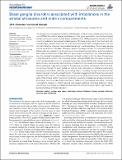| dc.contributor.author | Crittenden, Jill R. | |
| dc.contributor.author | Graybiel, Ann M. | |
| dc.date.accessioned | 2012-05-10T23:15:54Z | |
| dc.date.available | 2012-05-10T23:15:54Z | |
| dc.date.issued | 2011-08 | |
| dc.date.submitted | 2011-06 | |
| dc.identifier.issn | 1662-5129 | |
| dc.identifier.issn | 1662-5129 | |
| dc.identifier.uri | http://hdl.handle.net/1721.1/70572 | |
| dc.description.abstract | The striatum is composed principally of GABAergic, medium spiny striatal projection neurons (MSNs) that can be categorized based on their gene expression, electrophysiological profiles, and input–output circuits. Major subdivisions of MSN populations include (1) those in ventromedial and dorsolateral striatal regions, (2) those giving rise to the direct and indirect pathways, and (3) those that lie in the striosome and matrix compartments. The first two classificatory schemes have enabled advances in understanding of how basal ganglia circuits contribute to disease. However, despite the large number of molecules that are differentially expressed in the striosomes or the extra-striosomal matrix, and the evidence that these compartments have different input–output connections, our understanding of how this compartmentalization contributes to striatal function is still not clear. A broad view is that the matrix contains the direct and indirect pathway MSNs that form parts of sensorimotor and associative circuits, whereas striosomes contain MSNs that receive input from parts of limbic cortex and project directly or indirectly to the dopamine-containing neurons of the substantia nigra, pars compacta. Striosomes are widely distributed within the striatum and are thought to exert global, as well as local, influences on striatal processing by exchanging information with the surrounding matrix, including through interneurons that send processes into both compartments. It has been suggested that striosomes exert and maintain limbic control over behaviors driven by surrounding sensorimotor and associative parts of the striatal matrix. Consistent with this possibility, imbalances between striosome and matrix functions have been reported in relation to neurological disorders, including Huntington’s disease, L-DOPA-induced dyskinesias, dystonia, and drug addiction. Here, we consider how signaling imbalances between the striosomes and matrix might relate to symptomatology in these disorders. | en_US |
| dc.description.sponsorship | Eunice Kennedy Shriver National Institute of Child Health and Human Development (U.S.) (R01-HD028341) | en_US |
| dc.description.sponsorship | Brain & Behavior Research Foundation (Distinguished Investigator Award) | en_US |
| dc.description.sponsorship | Grayce B. Kerr Fund, Inc. | en_US |
| dc.description.sponsorship | McGovern Institute for Brain Research at MIT (James and Pat Poitras Research Fund) | en_US |
| dc.description.sponsorship | McGovern Institute for Brain Research at MIT (Stanley H. and Sheila G. Sydney Fund) | en_US |
| dc.description.sponsorship | Tourette Syndrome Association | en_US |
| dc.description.sponsorship | Simons Foundation | en_US |
| dc.description.sponsorship | Broad Institute (Stanley Center for Psychiatric Research) | en_US |
| dc.description.sponsorship | MGH/MIT Morris Udall Center of Excellence in Parkinson Disease Research | en_US |
| dc.description.sponsorship | National Parkinson Foundation (U.S.) | en_US |
| dc.description.sponsorship | Michael J. Fox Foundation for Parkinson's Research | en_US |
| dc.language.iso | en_US | |
| dc.publisher | Frontiers Research Foundation | en_US |
| dc.relation.isversionof | http://dx.doi.org/10.3389/fnana.2011.00059 | en_US |
| dc.rights | Article is made available in accordance with the publisher's policy and may be subject to US copyright law. Please refer to the publisher's site for terms of use. | en_US |
| dc.source | Frontiers | en_US |
| dc.title | Basal Ganglia Disorders Associated with Imbalances in the Striatal Striosome and Matrix Compartments | en_US |
| dc.type | Article | en_US |
| dc.identifier.citation | Crittenden, Jill R., and Ann M. Graybiel. “Basal Ganglia Disorders Associated with Imbalances in the Striatal Striosome and Matrix Compartments.” Frontiers in Neuroanatomy 5 (2011): p.1-25. | en_US |
| dc.contributor.department | Massachusetts Institute of Technology. Department of Brain and Cognitive Sciences | en_US |
| dc.contributor.department | McGovern Institute for Brain Research at MIT | en_US |
| dc.contributor.approver | Graybiel, Ann M. | |
| dc.contributor.mitauthor | Crittenden, Jill R. | |
| dc.contributor.mitauthor | Graybiel, Ann M. | |
| dc.relation.journal | Frontiers in Neuroanatomy | en_US |
| dc.eprint.version | Final published version | en_US |
| dc.type.uri | http://purl.org/eprint/type/JournalArticle | en_US |
| eprint.status | http://purl.org/eprint/status/PeerReviewed | en_US |
| dspace.orderedauthors | Crittenden, Jill R.; Graybiel, Ann M. | en |
| dc.identifier.orcid | https://orcid.org/0000-0002-4326-7720 | |
| mit.license | PUBLISHER_POLICY | en_US |
| mit.metadata.status | Complete | |
